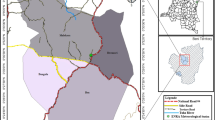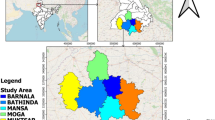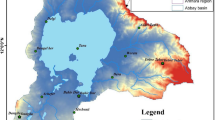Abstract
Trends of the three hydro-meteorological variables, including precipitation, temperature, and river discharge have been studied to detect the impacts of climate change on water resources in western Caspian Sea region, Iran. We used Kendall’s tau, Spearman’s rho, Sen’s slope estimator, and Mann–Kendall approaches to detecting the annual and seasonal trends over the period 1981–2010. The nonparametric tests detected statistically significant decreasing trends in all of the hydrometric stations. In general, magnitude of an annual downward trend in the hydrometric stations was 2.17 m3/s per decade at the 5% significance level. As the results of the Pettitt test for detecting abrupt changes (jumps), the change points (or trends started) in river flow series were found in all hydrometric stations in the years of 1994–1999 at the significance level of 0.05%. Meanwhile, the outputs exhibited that majority of the annual and seasonally precipitation trends were increasing in contrast to the river discharge trends. Furthermore, on average, magnitude of annual temperature increasing trend was found (+) 0.43 °C per decade at the 0.05 significant level. Abrupt changes in the annual temperature as same as river flow series were at the 1990s over the period 1981–2010. The Pearson correlation was used to explore the relationships between river flow, temperature, and precipitation time series. Finally, the high correlation was obtained from the area-averaged temperature and discharge series at the autumn and annual time series with the value of the (−) 59 and (−) 50%. It is concluded that decreasing the river discharge might be related to increasing temperature and decreasing precipitation and anthropogenic changes in the study area.







Similar content being viewed by others
References
Abghari H, Tabari H, Talaee PH (2013) River flow trends in the west of Iran during the past 40 years: impact of precipitation variability. Glob Planet Change 101:52–60
Aziz OIA, Burn DH (2006) Trends and variability in the hydrological regime of the Mackenzie River Basin. J Hydrol 319:282–294
Bihamta M, Zarehchahouki M (2010) Principles of statistics for the natural resources science. University of Tehran, Tehran, p 255 (in Persian)
Birsan MV, Molnar P, Burlando P, Pfaundler M (2005) Streamflow trends in Switzerland. J Hydrol 314:312–329
Bostan PA, Akyüre Z (2007) Exploring the mean annual precipitation and temperature values over Turkey by using environmental variables. In: ISPRS joint workshop “visualization and exploration of geospatial data”. University of Applied Sciences, Stuttgart, Germany
Christopher J Martinez, Jerome J Maleski, Martin F Miller (2012) Trends in precipitation and temperature in Florida, USA. J Hydrol 452–453:259–281
Douglas EM, Vogel RM, Kroll CN (2000) Trends in floods and low flows in the United States: impact of spatial correlation. J Hydrol 240:90–105
Farajzadeh J, Alizadeh F (2017) A hybrid linear-nonlinear approach to predict the monthly rainfall over the Urmia Lake watershed using wavelet-SARIMAX-LSSVM conjugated model. J Hydroinf. https://doi.org/10.2166/hydro.2017.013
Guobin F, Shulin C, Changming L, Dawn S (2004) Hydro-climatic trends of the Yellow River Basin for the last 50 years. Clim Change 65:149–178
Hamed K (2008) Trend detection in hydrologic data: the Mann–Kendall trend test under the scaling hypothesis. J Hydrol 349:350–363
Hirsch RM, Slack JR, Smith RA (1982) Techniques of trend analysis for monthly water quality data. Water Resour Res 18(1):107–121
IPCC (2014) Summary for policymakers. Contribution of working group I to the fifth assessment report of the intergovernmental panel on climate change. Cambridge University Press, pp 1–44
Jiang T, Su B, Hartmann H (2007) Temporal and spatial trends of precipitation and river flow in the Yangtze River Basin, 1961–2000. Geomorphology 85:143–154
Kahya E, Kalayci S (2004) Trend analysis of streamflow in Turkey. J Hydrol 289:128–144
Kang H, Yusof F (2012) Homogeneity tests on rainfall series in Peninsular Malaysia. Int J Contemp Math Sci 7(1):9–22
Karmeshu N (2012) Trend detection in annual temperature and precipitation using the Mann–Kendall test—a case study to assess climate change on select states in the northeastern United States, vol 32. MSC thesis, University of Pennsylvania, pp 1–27
Karpouzos DK, Kavalieratou S, Babajimopoulos C (2010) Non-parametric trend analysis of precipitation data in Pieria region (Greece). Eur Water 30:31–40
Kendall MG (1975) Rank correlation measures. Charles Griffin, London, p 736p
Lettenmaier DP, Wood EF, Wallis JR (1994) Hydro-climatological trends in the continental United States (1948–1988). J Clim 7:586–607
Mann HB (1945) Non-parametric tests against trend. Econometrica 13:245–259
McCuen RH (2002) Modeling hydrologic change: statistical methods. Lewis Publishers, Boca Raton, p 433
Partal T, Kahya E (2006) Trend analysis in Turkish precipitation data. Hydrol Process 20:2011–2026
Pettitt AN (1979) A non-parametric approach to the change-point detection. Appl Stat 28:126–135
Ramazanpour M, Roshani M (2011) Seasonal trend analysis of precipitation and discharge parameters in Guilan, North of the Iran. World Appl Sci J 14(9):1286–1290
Roushangar K, Alizadeh F (2017) Identifying complexity of annual precipitation variation in Iran during 1960–2010 based on information theory and discrete wavelet transform. Stoch Env Res Risk Assess. https://doi.org/10.1007/s00477-017-1430-z
Schaefer D, Domroes M (2008) Recent climate change in Japan—spatial and temporal characteristics of trends of temperature. Clim. Past 5:13–19
Sen PK (1968) Estimates of the regression coefficient based on Kendall’s tau. J Am Stat Assoc 39:1379–1389
Siegel S (1956) Nonparametric statistics for the behavioral sciences. McGraw-Hill, New York, p 312p
Tabari H, Talaee PH (2011a) Recent trends of maximum and minimum air temperatures in the western half of Iran. Meteorol Atmos Phys 111:121–131
Tabari H, Talaee PH (2011b) Temporal variability of precipitation over Iran: 1966–2005. J Hydrol 396:313–320
Tabari H, Abghani H, Talaee PH (2012) Temporal trends and spatial characteristics of drought and rainfall in arid and semi-arid regions of Iran. Hydrol Process 26(22):3351–3361
Tekleab S, Mohamed Y, Uhlenbrook S (2013) Hydro-climatic trends in the Abay/Upper Blue Nile basin, Ethiopia. Phys Chem Earth 61–62:32–42
Theil H (1950) A rank-invariant method of linear and polynomial regression analysis Part 3. Proc Koninalijke Nederlandse Akademie van Weinenschatpen A53:1397–1412
Ventura F, Rossi Pisa P, Ardizzoni E (2002) Temperature and precipitation trends in Bologna (Italy) from 1952 to 1999. Atmos Res 61:203–214
Xu ZX, Takeeuchi K, Ishidaira H (2003) Monotonic trend and seep changes in Japanese precipitation. J Hydrol 279:144–150
Yavuz H, Erdoğan S (2012) Spatial analysis of monthly and annual precipitation trends in Turkey. Water Resour Manage 26:609–621
Yenigun K, Gumus V, Bulut H (2008) Trends in stream flow of the Euphrates basin, Turkey. Proc Inst Civil Eng Water Manage 161:189–198. https://doi.org/10.1680/wama.2008.161.4.189
You Q, Min J, Fraedrich K, Zhang W, Kangc Sh, Zhang L, Meng X (2013) Projected trends in mean, maximum, and minimum surface temperature in China from simulations. Glob Planet Change 112:53–63
Zarenistanak M, Dhorde AG, Kripalani RH (2014) Trend analysis and change point detection of annual and seasonal precipitation and temperature series over southwest Iran. J Earth Syst Sci 123(2):281–295
Zongxue Xu, Zhaofei Liu, Guobin Fu, Chen Yaning (2010) Trends of major hydro-climatic variables in the Tarim River basin during the past 50 years. J Arid Environ 74:256–267
Author information
Authors and Affiliations
Corresponding author
Rights and permissions
About this article
Cite this article
Kazemzadeh, M., Malekian, A. Changeability evaluation of hydro-climate variables in Western Caspian Sea region, Iran. Environ Earth Sci 77, 120 (2018). https://doi.org/10.1007/s12665-018-7305-x
Received:
Accepted:
Published:
DOI: https://doi.org/10.1007/s12665-018-7305-x




